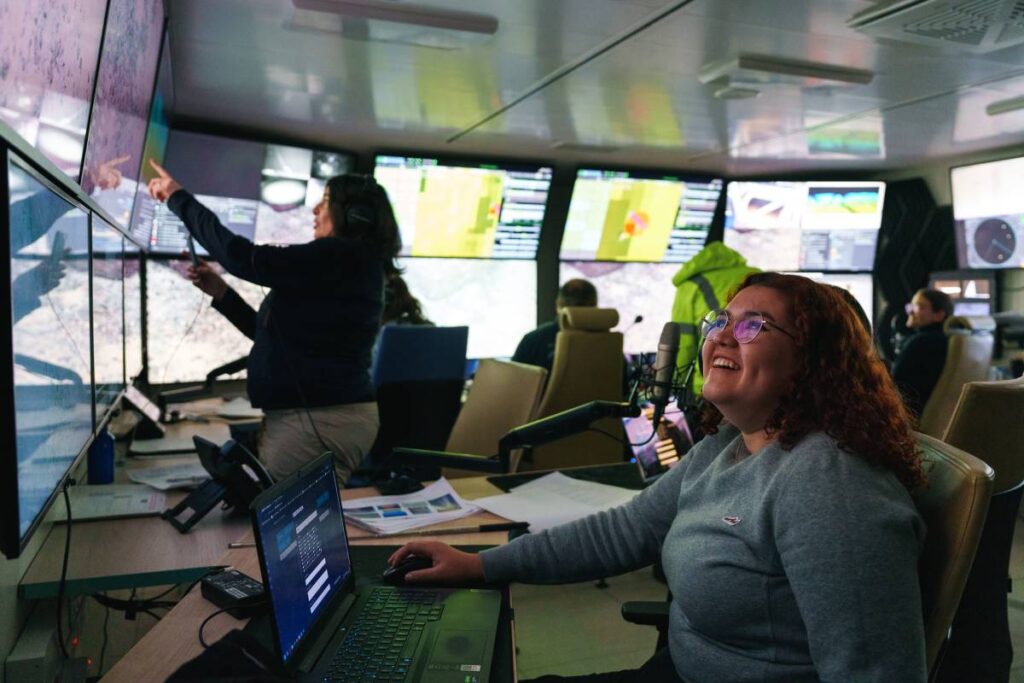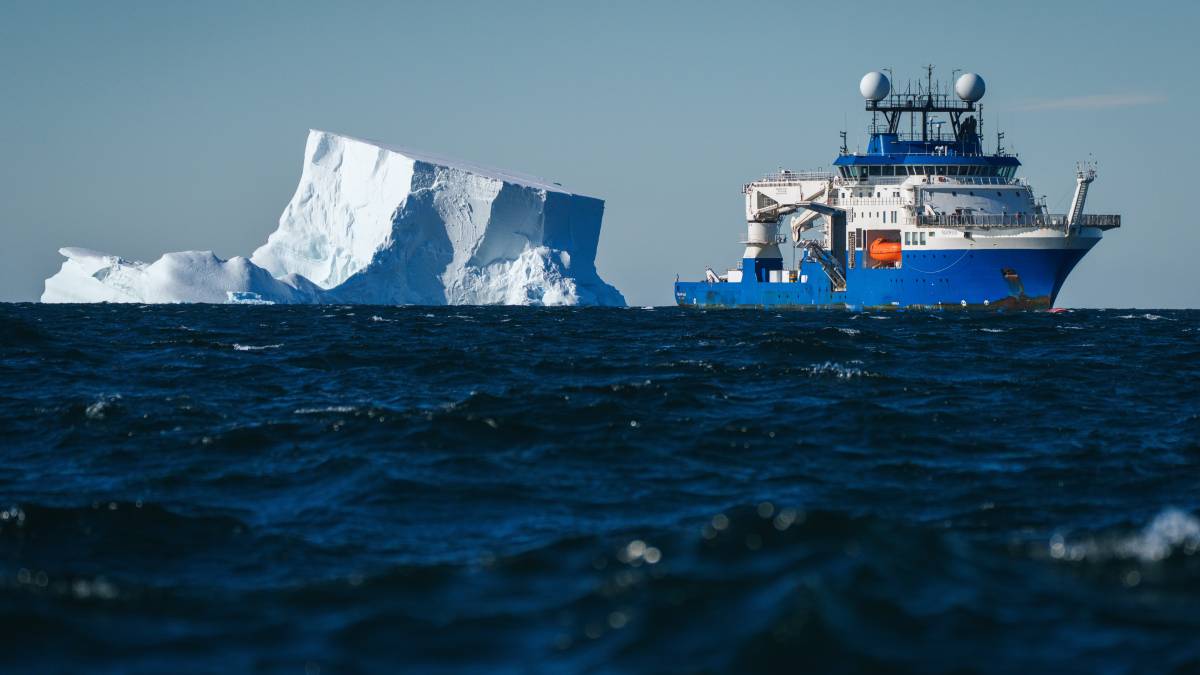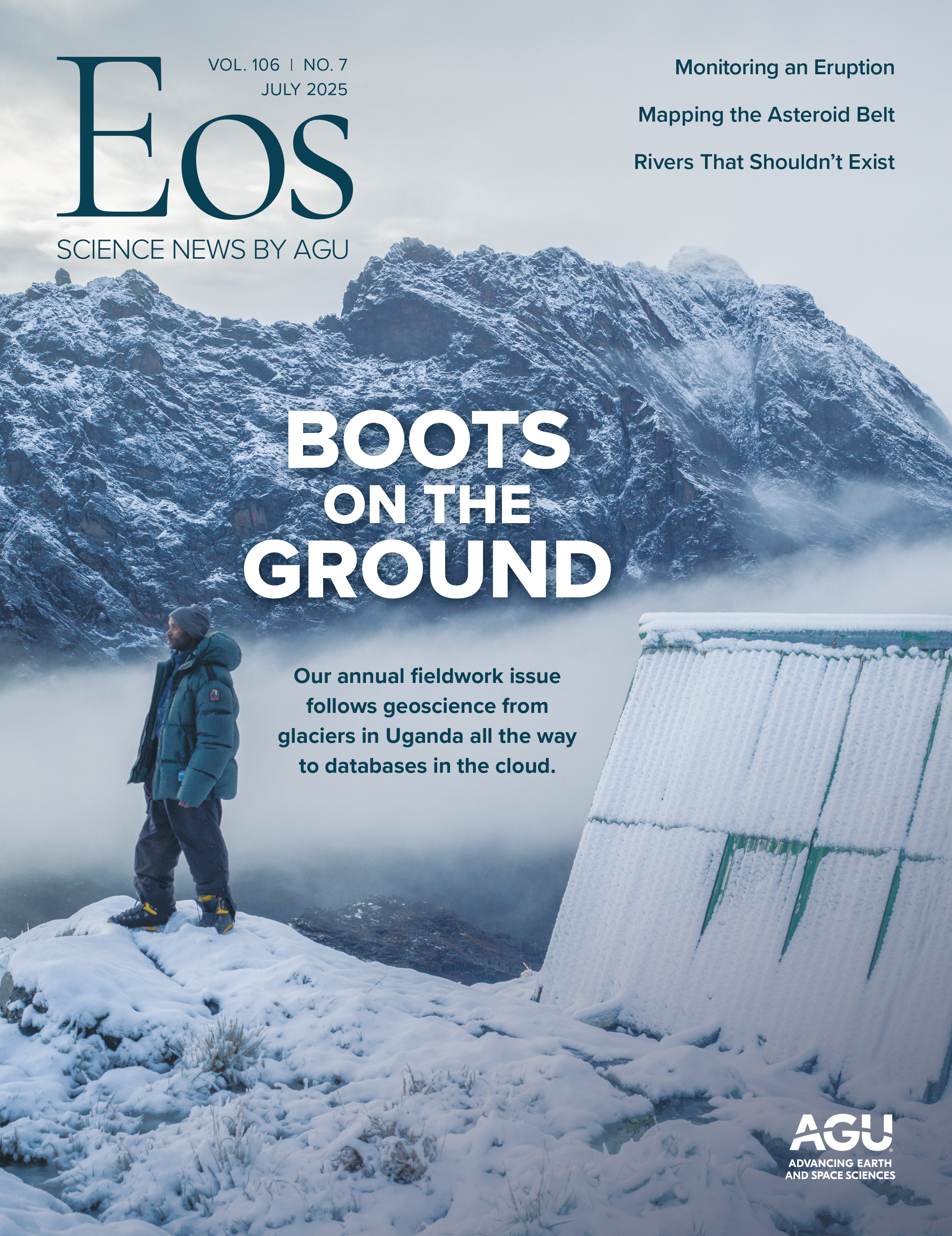In mid-January, a team of scientists were sailing aboard a research vessel in frigid Antarctic waters. They planned to investigate an unexplored section of the Bellingshausen Sea and the creatures that live there, but were stymied by more sea ice than they expected.
“We found ourselves restricted to a smaller area,” said Patricia Esquete, a marine biologist at the Universidade de Aveiro in Portugal and expedition co–chief scientist. “Instead of Bellingshausen Sea, we were restricted to the Ronne Entrance.” The team made the most of the situation, and their research vessel, Schmidt Ocean Institute’s R/V Falkor (too), settled in to conduct science operations in front of the ice shelf.
“We immediately decided to go there and see [what] the seafloor looks like under the ice.”
While checking satellite images of sea ice extent, they noticed that a crack had formed along the edge of the George VI ice shelf about 30 kilometers from their location. They jotted it down but didn’t worry about any dangers it posed. Such cracks can take weeks or months to fully force a break from the shelf and form an iceberg, Esquete explained.
But when the next batch of satellite images came through a few days later, the team was surprised to see that a 510-square-kilometer (209-square-mile) iceberg had broken off and was drifting along (and occasionally bumping against) the coast of the Antarctic Peninsula. The departure of the Chicago-sized iceberg, A-84, revealed a patch of polar seafloor that had been covered by ice for years, and possibly centuries.
“As soon as we realized that the iceberg had moved on and left that space for us to sample, we immediately decided to go there and see [what] the seafloor looks like under the ice,” Esquete said. When they arrived, they found a thriving ecosystem rivaling those in nutrient-rich open waters.
Luck and Daring
Before A-84 calved, the team was poised to document the biodiversity of a nearby deep-sea ecosystem, collect sediment samples, study underwater ocean dynamics, and create seafloor maps.
“A holy grail for oceanography is not only mapping the entirety of the deep seabed in high resolution in terms of its shape and structure, but also in terms of specifically what lives there and how,” said Dawn Wright, an oceanographer and chief scientist at Environmental Systems Research Institute (Esri) in Redlands, Calif., who was not involved with this expedition.
Sea ice impedes that goal: Research vessels can’t get too close to the ice shelf, and remotely operated vehicles (ROVs) and autonomous underwater vehicles can travel only so far from the ship to explore under the ice.

The procedures involved in securing funding and scheduling a ship can make seagoing research in the Antarctic a slow process, explained Joan Bernhard, a biological oceanographer at Woods Hole Oceanographic Institution in Massachusetts. Planning an expedition like the one in January can take years or even decades, with few exceptions.
Some expeditions have been able to mobilize when seafloor is newly exposed. After Larsen C calved in 2017, for example, research vessels arrived in the area about a year later—much faster than average. Changes at the surface take time to affect the seafloor, but even with such a quick response time, researchers still missed the opportunity to establish a precalving baseline.
After most calvings, “any newly exposed seafloor will have been subject to open-water conditions for years; currents could import alien species potentially impactful to indigenous taxa,” said Bernhard, who was not involved with the Falkor (too) expedition.
Iceberg A-84 calved on 13 January. Falkor (too) reached the newly exposed seafloor just 12 days later.
“Good luck played a huge role. We cannot deny that. But there’s also value in daring to explore the unexplored.”
After relocating, the researchers conducted the same suite of science observations they had originally planned, just in the newly exposed location. Thanks to the quick pivot, the team was able to observe the area as if it were still covered by the ice—an “incredibly rare” opportunity, Bernhard said.
“In my view, nowhere has serendipity in ocean science proved more critical,” Wright said of the expedition. Operating in those conditions is hard enough, and it’s even tougher to be in the right place at the right time, she added.
Esquete acknowledged the expedition’s fortune. “Good luck played a huge role. We cannot deny that,” she said. “But there’s also value in daring to explore the unexplored.” The team would have missed the opportunity had they not already been exploring one of the most remote parts of the world.
Thriving Beneath the Ice
The researchers collected sediment samples, used lidar to create bathymetric maps, and studied the water column and ocean currents. They are still analyzing those data. They also deployed the ROV SuBastian to document the biodiversity of the deep sea and found a thriving ecosystem spanning the trophic web: corals, sponges, invertebrates, cephalopods, king crabs, and krill, as well as a few unknown species.
“I was excited to see what appeared to be meter-tall sponges, ‘giant’ pycnogonids (sea spiders), and large ophiuroids (brittle stars), all similar to those known from the McMurdo Sound region,” Bernhard said.
“What surprised me was the sheer variety of organisms that were found, as well as the huge sizes of some of the deep-sea sponges that had apparently been growing for hundreds of years under such harsh Antarctic conditions,” Wright said.
What’s more, the team found several species that filled discrete ecological niches, which suggested that the ice-covered ecosystem received a steady, high-level influx of nutrients and may have been there for a while, Esquete said.
“Basically, we found the same type of ecosystems that you can expect in that area of the Bellingshausen Sea,” Esquete said. But unlike the other areas the team studied, this ecosystem thrived “in an area that’s been permanently covered by ice for probably centuries.”
That in itself was surprising, she said. Most deep-sea ecosystems that aren’t covered by thick ice receive nutrients that trickle down from photosynthetic organisms near the surface. Scientists think that nutrients carried on deep-sea currents supply nutrients to benthic ecosystems where ice prevents top-down nutrient delivery.
“I was mildly surprised by the plethora of sea anemones on a boulder adjacent to a barrel sponge because all are filter feeders,” Bernhard said. “Such abundance implies currents are strong enough to transport sufficient organic matter to this area.”
A Future Without Ice
The Falkor (too) researchers returned to the mainland after weeks studying the newly discovered Bellingshausen habitat. They already hope for a return trip to investigate how that patch of seafloor changes now that its icy cover has drifted off. Nutrients trickling down from photosynthetic algae might now be available, but the ecosystem has already adapted to and thrived on a lower nutrient supply.
As climate change melts Antarctic ice, this ecosystem could be a bellwether for changes across polar ecosystems.
“Open-water conditions may imperil these ecosystems,” Bernhard said. “More settlement of organics to the seafloor…could cause an ecological imbalance.”
As climate change melts Antarctic ice, this ecosystem could be a bellwether for changes across polar ecosystems.
“The accelerating loss of polar ice that protects these ecosystems, including channeling of nutrient-rich currents to them, does not bode well for their vitality,” Wright said. “But there is so much that we just don’t know. The oceanographic community will be watching the results of this expedition as they become available with intense interest. It has direct bearing on the overall health of the planet.”
—Kimberly M. S. Cartier (@astrokimcartier.bsky.social), Staff Writer



